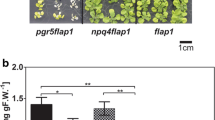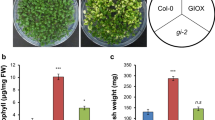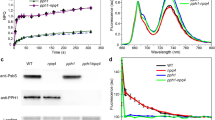Abstract
Arabidopsis gun4 mutant is defected in retrograde signaling and is characterized by reduced levels of chlorophyll. However, the impact of this mutation on plant photosynthetic performance remains unclear. We carried out a physiological characterization of gun4 in order to investigate the role of GUN4 for plant photosynthetic performance under light stress. The gun4 plants showed reduced minimal fluorescence in dark-adapted leaves and quantum yield of unregulated energy dissipation of photosystem II (PSII) under non-light-stress condition. The effective quantum yield of the PSII (ΦPSII) and photochemical quenching (qL) were higher in gun4 plants. Higher values of ΦPSII were also observed in gun4 under different light intensities. However, the rate of net carbon assimilation and stomatal conductance were lower in gun4. No differences were detected between the genotypes in the total absorption of 14CO2 as well as in the percentage of 14C flux to basic amino acids, sugars, starch, and cell wall. After light stress, the potential quantum yield of PSII decreased only in wild type and the non-photochemical quenching was higher in gun4. Taken together, the results suggest that gun4 transfers more efficiently the excess of light energy absorbed despite a reduction in chlorophyll and carotenoids content and has greater capacity to dissipate the excess of energy absorbed.





Similar content being viewed by others
Abbreviations
- ΦPSII :
-
Effective quantum yield of PSII
- GUN:
-
Genome uncoupled
- gun4 :
-
Genome uncoupled 4 mutant
- LHCB:
-
Light harvesting chlorophyll binding proteins
- LHC:
-
Light harvesting complex
- LHCII:
-
Light harvesting complex of the complex II
- Fm :
-
Maximal fluorescence in dark adapted leaves
- Fo :
-
Minimal fluorescence in dark adapted leaves
- MgChl:
-
Mg-chelatase enzyme
- Mg-ProtoIX:
-
Mg-protoporphyrinIX
- A :
-
Net photosynthetic rate
- qN:
-
Non-photochemical quenching
- ΦP :
-
Photochemical quantum yield of PSII
- qL:
-
Photochemical quenching of lake model
- PSII:
-
Photosystem II
- Fv/Fm :
-
Potential quantum yield of PSII
- ProtoIX:
-
ProtoporphyrinIX
- ΦNO :
-
Quantum yield of non-regulated non-photochemical energy loss in PSII
- g s :
-
Stomatal conductance
- C i :
-
Substomatal CO2 concentration
- E :
-
Transpiration
- WT:
-
Wild type
References
Adhikari ND, Orler R, Chory J, Froehlich JE, Larkin RM (2009) Porphyrins promote the association of GENOMES UNCOUPLED 4 and Mg-chelatase subunit with chloroplast membranes. J Biolog Chem 284(37):24783–24796
Apel K, Hirt H (2004) Reactive oxygen species: metabolism, oxidative stress, and signal transduction. Annu Rev Plant Biol 55:373–399
Bilger W, Schreiber U (1986) Energy-dependent quenching of dark level chlorophyll fluorescence in intact leaves. Photosynth Res 10:303–308
Bolhàr-Nordenkampf HR, Öquist GO (1993) Chlorophyll fluorescence as a tool in photosynthesis research. In: Hall DO, Scurlock JMO, Bolhàr-Nordenkampf HR, Leegood RC, Long SP (eds) Photosynthesis and production in a changing environment. Chapman & Hall, London, pp 193–205
Brzezowski P, Schlicke H, Richter A, Dent RM, Niyogi KK, Grimm B (2014) The GUN4 protein plays a regulatory role in tetrapyrrole biosynthesis and chloroplast-tonucleus signalling in Chlamydomonas reinhardtii. Plant J. doi:10.1111/tpj.12560
Czarnecki O, Gläßer C, Chen JG, Mayer KFX, Grimm B (2012) Evidence for a contribution of ALA synthesis to plastid-to-nucleus signaling. Front Plant Sci 3:1–19
DaMatta FM, Cunha RL, Antunes WC, Martins SCV, Araujo WL, Fernie AR, Moraes GABK (2008) In field-grown coffee trees source–sink manipulation alters photosynthetic rates, independently of carbon metabolism, via alterations in stomatal function. New Phytol 178:348–357
Demmig-Adams B, Adams WW (1992) Photoprotection and other responses of plants to high light stress. Annu Rev Plant Physiol Plant Mol Biol 43:599–626
Eberhard S, Finazzi G, Wollman FA (2008) The dynamics of photosynthesis. Annu Rev Genet 42:463–515
Flexas J, Ortuño MF, Ribas-Carbo M, Diaz-Espejo A, Flórez-Sarasa ID, Medrano H (2007) Mesophyll conductance to CO2 in Arabidopsis thaliana. New Phytol 175:501–511
Formighieri C, Ceol M, Bonente G, Rochaix JD, Bassi R (2012) Retrograde signaling and photoprotection in a gun4 mutant of Chlamydomonas reinhardtii. Mol Plant 5(6):1242–1262
Genty B, Briantais JM, Baker NR (1989) The relationship between the quantum yield of photosynthetic electron transport and quenching of chlorophyll fluorescence. Biochim Biophys Acta 990:87–92
Hansson A, Jensen PE (2009) Chlorophyll limitation in plants remodels and balances the photosynthetic apparatus by changing the accumulation of photosystems I and II through two different approaches. Physiol Plant 135:214–228
Havaux M, Dall’Osto L, Bassi R (2007) Zeaxanthin has enhanced antioxidant capacity with respect to all other xanthophylls in Arabidopsis leaves and functions independent of binding to PSII antennae. Plant Physiol 145:1506–1520
Hu Z, Xu F, Guan L, Qian P, Liu Y, Zhang H, Huang Y, Hou S (2014) The tetratricopeptide repeat-containing protein slow green1 is required for chloroplast development in Arabidopsis. J Exp Bot 65(4):1111–1123
Kitajima M, Butler WL (1975) Quenching of chlorophyll fluorescence and primary photochemistry in chloroplasts by dibromothymoquinone. Biochim Biophys Acta 376:105–115
Kleine T, Voigt C, Leister D (2009) Plastid signalling to the nucleus: messengers still lost in the mists? Trends Genet 25(4):185–192
Klughammer C, Schreiber U (2008) Complementary PSII quantum yield calculated from simple fluorescence parameters measured by PAM fluorometry and saturation pulse method. PAM Appl Notes 1:27–35
Koussevitzky S, Nott TC, Mockler FH, Sachetto-Martins G, Surpin MJ, Chory J (2007) Multiple signals from damaged chloroplasts converge on a common pathway to regulate nuclear gene expression. Science 316:715–719
Kramer DM, Johnson G, Kiirats O, Edwards GE (2004) New fluorescence parameters for the determination of QA redox state and excitation energy fluxes. Photosynth Res 79:209–218
Larkin RM, Ruckle ME (2008) Integration of light and plastid signals. Curr Opin Plant Biol 11:1–7
Larkin RM, Alonso JM, Ecker JR, Chory J (2003) GUN4, a regulator of chlorophyll synthesis and intracellular signaling. Science 299:902–906
Li Z, Wakao S, Fisher BB, Niyogi KK (2009) Sensing and responding to excess light. Annu Rev Plant Biol 60:239–260
Lichtenthaler HK (1987) Chlorophylls and carotenoids: pigments of photosynthetic biomembranes. Methods Enzimol 148:350–382
Masuda T, Fujita Y (2008) Regulation and evolution of chlorophyll metabolism. Photochem Photobiol Sci 7:1131–1149
Maxwell K, Johnson GN (2000) Chlorophyll fluorescence-a practical guide. J Exp Bot 51:659–668
Mochizuki N, Brusslan JÁ, Larkin R, Nagatani A, Chory J (2001) Arabidopsis genomes uncoupled 5 (GUN5) mutant reveals the involvement of Mg-chelataseH subunit in plastid-nucleus signal transduction. Proc Natl Acad Sci USA 98:2053–2058
Mochizuki N, Tanaka R, Tanaka A, Masuda T, Nagatani A (2008) The steady state level of Mg-protoporphyrin IX is not a determinant of plastid-to-nucleus signaling in Arabidopsis. Proc Natl Acad Sci USA 105:15184–15189
Moulin M, McCormac AC, Terry MJ, Smith AG (2008) Tetrapyrrole profiling in Arabidopsis seedlings reveals that retrograde plastid nuclear signaling is not due to Mg-protoporphyrin IX accumulation. Proc Natl Acad Sci USA 105:15178–15183
Murashige T, Skoog F (1962) A revised medium for rapid growth and bioassays with tobacco tissue cultures. Physiol Plant 15:473–497
Nott A, Jung HS, Koussevitzky S, Chory J (2006) Plastid-to-nucleus retrograde signalling. Annu Rev Plant Biol 57:739–759
Obayashi T, Kinoshita K (2009) Rank of correlation coefficient as a comparable measure for biological significance of gene coexpression. DNA Res 16(2009):249–260
Obayashi T, Hayashi S, Saeki M, Ohta H, Kinoshita K (2009) ATTED-II provides coexpressed gene networks for Arabidopsis. Nucleic Acids Res 37:D987–D991
Obayashi T, Nishida K, Kasahara K, Kinoshita K (2011) ATTED-II updates: condition-specific gene coexpression to extend coexpression analyses and applications to a broad range of flowering plants. Plant Cell Physiol 52:213–219
Peter E, Grimm B (2009) GUN4 is required for posttranslational control of plant tetrapyrrole biosynthesis. Mol Plant 2(6):1198–1210
Pfannschmidt T (2010) Plastidial retrograde signalling––a true ‘‘plastid factor’’ or just metabolite signatures? Trends Plant Sci 15:427–435
Sobotka R, Dühring U, Komenda J, Peter E, Gardian Z, Tichy M, Grimm B, Wilde A (2008) Assembly of photosynthetic complexesprotein for chlorophyll metabolism and importance of the cyanobacterial Gun4. J Biol Chem 283:25794–25802
Susek RE, Chory J (1992) A tale of two genomes: role of a chloroplast signal in coordinating nuclear and plastid genome expression. Aust J Plant Physiol 19:387–399
Susek RE, Ausubel FM, Chory J (1993) Signal transduction mutants of Arabidopsis uncouple nuclear CAB and RBCS gene expression from chloroplast development. Cell 74:787–799
Tanaka R, Tanaka A (2007) Tetrapyrrole biosynthesis in higher plants. Annu Rev Plant Biol 58:321–346
Teramoto H, Ono T, Minagawa J (2001) Identification of Lhcb gene family encoding the light-harvesting chlorophyll-a/b proteins of photosystem II in Chlamydomonas reinhardtii. Plant Cell Physiol 42:849–856
Walters RG (2005) Towards an understanding of photosynthetic acclimation. J Exp Bot 56(411):435–447
Wilde A, Mikolajczyk S, Alawady A, Lokstein H, Grimm B (2004) The gun4 gene is essential for cyanobacterial porphyrin metabolism. FEBS Lett 571:119–123
Winter D, Vinegar B, Nahal H, Ammar R, Wilson GV et al (2007) An “Electronic Fluorescent Pictograph” browser for exploring and analyzing large-scale biological data sets. PLoS One 2(8):e718
Zeeman SC, Smith SM, Smith AM (2007) The diurnal metabolism of leaf starch. Biochem J 401:13–28
Zhang DP (2007) Signaling to the nucleus with a loaded GUN. Science 316:700–701
Zhou S, Sawicki A, Willows RD, Luo M (2012) C-terminal residues of Oryza sativa GUN4 are required for the activation of the ChlH subunit of magnesium chelatase in chlorophyll synthesis. FEBS Lett 586:205–210
Acknowledgments
This research was supported by the CNPq (National Council for Technological and Scientific Development, Brazil) and FAPEMIG (Foundation for Research Assistance of the Minas Gerais State, Brazil). Scholarships granted by CNPq, CAPES and FAPEMIG are gratefully acknowledged. DMD was recipient of a scholarship from CAPES.
Author information
Authors and Affiliations
Corresponding author
Electronic supplementary material
Below is the link to the electronic supplementary material.
Rights and permissions
About this article
Cite this article
Daloso, D.M., Antunes, W.C., Santana, T.A. et al. Arabidopsis gun4 mutant have greater light energy transfer efficiency in photosystem II despite low chlorophyll content. Theor. Exp. Plant Physiol. 26, 177–187 (2014). https://doi.org/10.1007/s40626-014-0025-z
Received:
Accepted:
Published:
Issue Date:
DOI: https://doi.org/10.1007/s40626-014-0025-z




